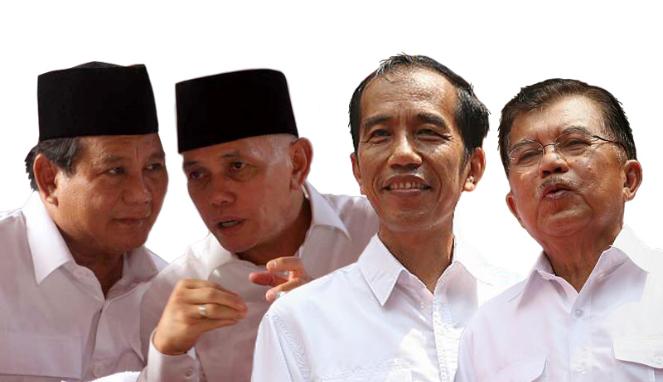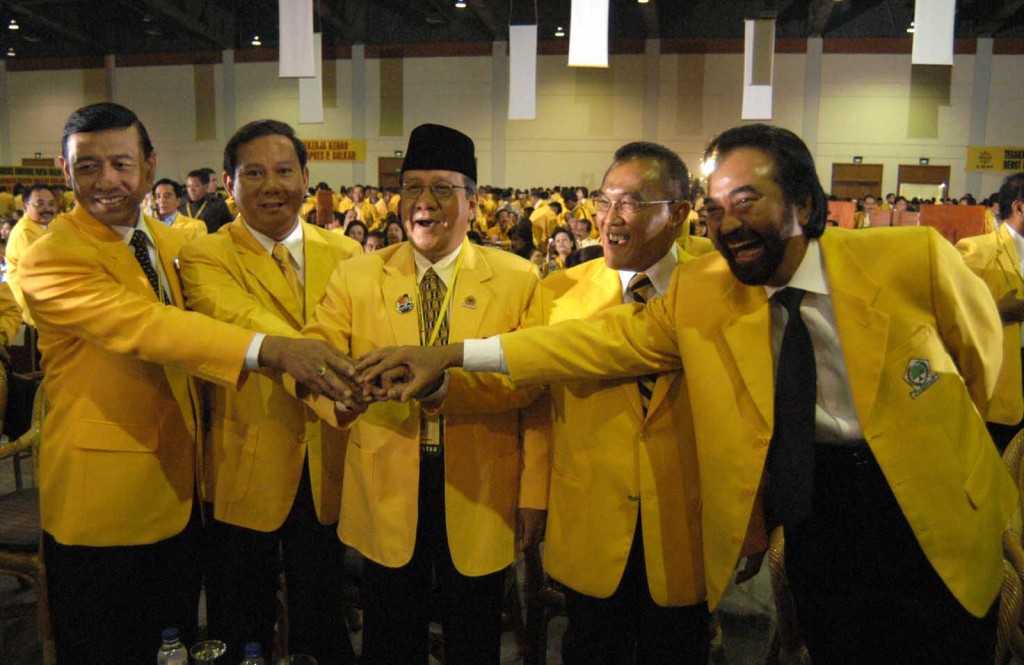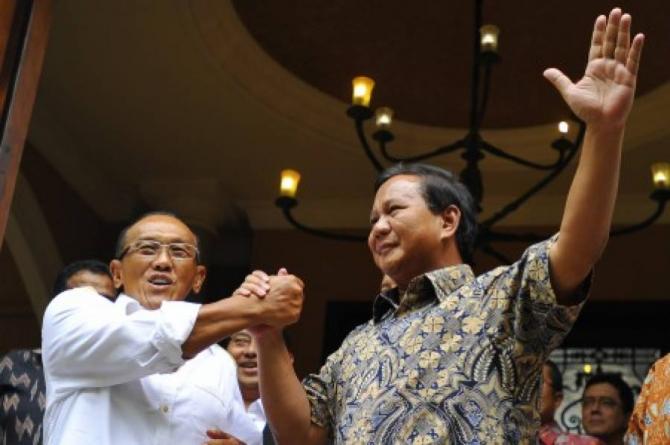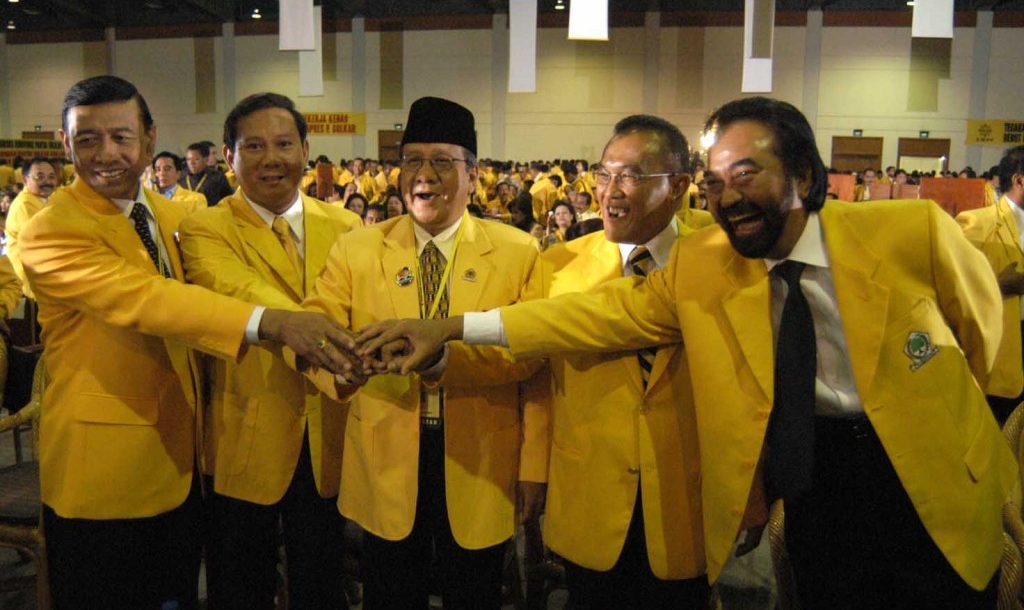Indonesia’s voters are facing their most fateful electoral decision since regaining their democratic rights fifteen years ago.
One presidential coalition, led by Jakarta governor and popular sensation Joko Widodo (Jokowi), combines socially rooted pluralist parties PDI-P and PKB with figures whose deepest roots lie in Suharto-era authoritarianism, especially its surviving Golkar party: vice-presidential candidate Jusuf Kalla, Hanura leader Wiranto, and NasDem leader Surya Paloh.
The other coalition is fronted by a self-styled populist, once-disgraced former General Prabowo Subianto. His Gerindra party has teamed up with two Islamist parties (PPP and PKS), one pluralist party rooted in the Islamic organization Muhammadiyah (PAN), and the current incarnation of Golkar, precariously led by one of Indonesia’s richest and most unpopular men, Aburizal Bakrie.
If red is the color of Indonesia’s pluralist nationalism, green represents its political Islam, and yellow stands for those forces defined more by their catch-all opportunism than any identifiable cleavage-based ideologies, the 2014 presidential election pits a reddish-yellow coalition under Jokowi against a greenish-yellow coalition led by Prabowo.
Why is so much at stake? Both coalitions may share a yellowish hue, but they are anything but equivalents. Prabowo’s coalition is a veritable rogues’ gallery. It has gathered the poster children of Indonesian human-rights abuses (Prabowo), religious intolerance (PPP leader Suryadharma Ali), and plutocratic unaccountability (Golkar’s Bakrie) in the same camp. If victorious, it would almost certainly deliver what is bad about populism–i.e. its disrespect for the rule of law and constraints on presidential power–without offering what is good about populism – i.e. its more active inclusion of ordinary people in political life. It cannot credibly commit either to combat corruption or protect pluralism.
The fatefulness of this election lies more in the great perils of Prabowo’s coalition than in the great promise of Jokowi’s.
Yet great promise there is, if Jokowi is able to seize both the electoral victory and the historical moment. As I argue below, the coalitions of 2014 are witnessing a partial, tenuous, but nonetheless real reemergence of the two ideological cleavages that so sharply defined Indonesian party politics upon its transition to democracy in 1998-99: a regime cleavage and a religious cleavage.
As I argue elsewhere, these cleavages have become dulled and blurred since 1999, due to party elites’ “promiscuous powersharing” and the resulting “cartelization” of the party system. As the coalitional dust settles, there is a very real prospect that party competition during and after the 2014 elections will be more sharply defined by debates and struggles over the deepening of democratic reform and the protection of Indonesia’s religious pluralism than it has been to date. This promise exists despite the fact that both camps have been engaging in serious (if again, not equivalent) promiscuous powersharing negotiations.
The main irony I wish to highlight is this: while ideological cleavages shaped the process but not the outcome of powersharing back in 1999, they may well be the outcome without driving the process of powersharing in 2014.

The Presidential and Vice Presidential Candidates. (From left) Prabowo Subianto, Hatta Rajasa, Joko Widodo, Jusuf Kalla
Cartelization, Indonesia-Style
What do I mean when I say that Indonesia’s party system has been cartelized since 1999, and that Jokowi’s coalition offers the promise of decisively mitigating this condition?
I do not mean that Indonesia’s parties are monolithic, disciplined, single-minded in their pursuit of power and patronage, or devoid of either ideological leanings or social linkages. As Marcus Mietzner has convincingly detailed in his new book, Indonesian parties are undisciplined, often uncooperative, at least intermittently driven by purposes besides seeking power and patronage, and more strongly socially rooted than parties in many other countries. Empirically, our disagreements on party politics are virtually nil. Our main difference is conceptual: can cartelization shed light on a party system that looks precious little like a well-oiled machine?
I argue that it can, but only if we do some necessary retooling of European cartel theory (as popularized by Richard Katz and Peter Mair) for the Indonesian context. It is implausible that a theory designed to depict and explain party behavior in old and rich European democracies could be exported, whole cloth, to a young and developing democracy like Indonesia. (Indeed, Katz and Mair have long been critiqued for over-claiming the coherence of their “cartel party model” in Europe itself. To the extent that they believe that their theory’s multiple components necessarily fit together as an unbreakable whole, they overreach. A party system may thus be cartelized in some ways but not in others, whether the founding fathers of cartelization theory like it or not.)
For instance, state subsidies for parties have very different implications in a setting where parties receive the bulk of their campaign funds from powerful plutocrats instead of their rank-and-file memberships. Nor does it make sense to think that the ostensible softening of class cleavages in “post-materialist” Europe would find any straightforward reflection in Indonesia. Questions of religious ideology and identity clearly remain an ongoing source of political controversy and concern, such that any talk of a “post-religious” Indonesian politics would be preposterous.
Then how do we know a cartelized party system when we see one?
It cannot be one in which political elites have neither personal rivalries nor ideological differences, since no such party system exists anywhere. It is one where such rivalries and differences, intense as they may be, do not compel elites to join identifiably and consistently different and competing political coalitions. It is one where every significant party expresses openness to sharing power with every other, even when those parties have profound ideological differences.
It is one where parties with plummeting electoral support suffer little to no consequences from their setbacks, because stronger parties remain willing to share power with them, their growing unpopularity (and by logical extension, the voters themselves) be damned. Neither electoral defeats nor ideological distance preclude a party from being invited to join a coalition under conditions of promiscuous powersharing. Once those coalitional partnerships are formed, parties may undermine, betray, and backstab each other. But so long as they stay in the same ruling coalition, they cannot by definition serve as opposition, because they cannot offer voters an electoral alternative to the incumbent government. The kind of undisciplined and inconsistent cooperation we see in Indonesian cabinets is not a substitute for disciplined and consistent opposition: it is practically its antithesis.
At the end of the day, a cartelized party system is one that fails to produce clear opposition parties offering voters the chance to hold incumbent parties accountable through their electoral removal. Most starkly put: It is a cartel when voters cannot vote against it.

Wiranto (Hanura), Prabowo Subianto (Gerindra). Akbar Tandjung (Golkar), Aburizal Bakrie (Golkar) and Surya Paloh (NasDem) from back in their ‘golden days’ together in the Golkar Party.
The Evolution of Promiscuous Powersharing
Yet cartelization is more subtle than stark. Like any political phenomenon, it arises and evolves unevenly. Hence we need to gauge it as a contingent, piecemeal, and reversible process, and not just determine its presence or absence as a fixed and final outcome. Indeed, one of my central arguments has long been that a party cartel was likely not a final outcome in Indonesia.
The “accountability trap” I warned against was not that Indonesian voters were trapped in a democracy without clear electoral alternatives. It was that cartelization gave Indonesia’s fledgling democracy an oligarchic taint that made it highly vulnerable to attack from a dangerous presidential populist (witness Prabowo). Being trapped meant being stuck between populism a la Prabowo and oligarchy a la Bakrie, not stuck in a cartelized oligarchy. The fact that Prabowo and Bakrie have now wound up in the same presidential coalition means that they offer, quite literally and worrisomely, the worst of both worlds.

Aburizal Bakrie (left) who had initially said he would join Jokowi’s coalition, ended up supporting Prabowo, with his Golkar party now part of Prabowo’s coalition. Photo credit: Strategic Review
By contrast, Jokowi’s coalition offers the promise that party cartelization might continue to abate, as it has over the past decade. It has abated, not because parties have stopped engaging in promiscuous powersharing, but because direct presidential elections have helped draw somewhat sharper lines between government and opposition since 2004. They have done so primarily through a disheartening if not outright antidemocratic mechanism: i.e. prompting the emergence of new parties as personal vehicles for the presidential ambitions of retired generals with deep experience in the authoritarian era.
First, the decision by Susilo Bambang Yudhoyono (SBY) to form the PD and challenge incumbent president Megawati in 2004 was made possible by a combination of new electoral rules and SBY’s personal quest to convert his military prestige into civilian glory. This sparked the SBY-Megawati personal feud, which has led Megawati to keep her PDIP “outside government” (luar pemerintahan, PDIP leaders’ own preferred term to oposisi) for the past decade. This has been despite the fact that PDIP should be more ideologically compatible with the PD than with other parties it shares power with quite readily and repeatedly. The “outside government” ranks then grew slightly after 2009 because Prabowo’s new Gerindra and Wiranto’s new Hanura were parties birthed to win the presidency for their leaders, not win ministries for their leaders’ underlings.
Direct presidential elections have reduced party cartelization less than one might expect, however. This is because SBY has not treated his landslide popular victories as occasions to relegate parties that opposed his candidacy to opposition, even after they suffered crushing defeats at the hands of Indonesia’s voters (including, in almost all cases, continuously declining vote totals in parliamentary elections). Golkar and PPP were brought into the cabinet despite opposing SBY in the 2004 vote, and Golkar was embraced by SBY again in 2009 after he trounced its ticket of Jusuf Kalla and Wiranto (whose current leading positions in the Jokowi coalition exemplify the limited negative repercussions of even the highest-profile electoral batterings).
SBY has even tried, relentlessly, to bring PDIP into the fold. Only Megawati’s personal refusal to forgive SBY’s defection–a refusal seemingly grounded in petulance more than principle–has kept party cartelization from returning to its 1999-2004 levels (when Megawati, ironically again, was herself vice-president and then president: i.e. promiscuous powersharer-in-chief). Even as PDIP has spent a decade outside the executive, SBY went out of his way to reward it with leadership positions in parliament – positions that are typically divided proportionally in parliamentary systems, but only among government parties, not opposition parties. All the while, every single party showed its willingness to share power with every other party in direct executive elections at the local level, further forestalling the emergence of any kind of identifiable alternative political blocs–ideologically grounded or otherwise–up until the present day.
Back to Blocs?
Considering the nationalist reddishness of Jokowi’s presidential coalition and the Islamic greenishness of Prabowo’s, ideological cleavages may well be regaining clear coalitional expression in Indonesia’s 2014 election. I say “regain” because Indonesia’s party system has long been partitioned along ideological lines, even during Suharto’s long repressive era (with its red PDI and green PPP).
As of 1999, it seemed self-evident that party coalitions would reflect the nationalist-Islamist divide as well as the regime cleavage between parties that had opposed Suharto and his ancien regime party, Golkar. Those cleavages profoundly shaped the 1999 parliamentary election campaign as well as the special parliamentary session that both removed authoritarian-era holdover B.J. Habibie from the presidency and denied it to “un-Islamic” Megawati. Still, neither the religious cleavage nor the regime cleavage shaped the coalitions of 1999, 2001, 2004, or 2009 in any appreciable way.
Promiscuous powersharing rather than ideologically defined powersharing has been the rule since reformasi.
Looking forward, it is critical to recognize that in 2014 as in 1999, coalitional strategies and outcomes might not ultimately align. Party leaders may not have strategically intended to build a cartelized coalition that eliminated all party opposition in 1999; but that was the upshot of their bargaining process that surprisingly delivered the presidency to Abdurrahman Wahid and the cabinet to…. everybody.
The reverse might be taking place in 2014. Powersharing negotiations between the April parliamentary elections and the May declaration of presidential coalitions looked basically as promiscuous as ever. Yet the upshot has been a coalitional constellation that not only distinguishes green from red, but that clusters the most threatening figures for Indonesia’s democratic consolidation – Prabowo’s rogue gallery – on the same side of the aisle.
Hence if Jokowi maintains his tenuous lead and prevails in the July election, he will merely have to do what directly elected presidents are generally expected to do – share executive power with the parties the voters have just chosen, but not with the parties they have just rejected – to pit a more pluralist and democratically credible ruling coalition against an opposition that abjectly lacks credibility on both of those critical fronts.
Or: recent past could be looming prologue. Like SBY, Jokowi may well invite parties like Golkar, PD, PPP, and PAN into his coalition even if he achieves a decisive victory. Certainly there are major leading figures in all those parties who will be champing at the bit to entice such a presidential invitation. And Jokowi’s camp is still ostensibly led by PDIP leader and ex-promiscuous-powersharer-in-chief Megawati, who would likely see a Jokowi presidency as the fruit of her personal mandate as much as the voters’.
Jokowi’s own expressed desire to cooperate with all parties, though not on the basis of sharing ministries, leaves ambiguous the forthcoming contours of government and opposition under a Jokowi administration. At a more structural level, the substantial yellowing of the party system since 2004 (with the addition of PD, Gerindra, Hanura, and NasDem) means that there is no longer any way for any Indonesian president to forge a majority coalition without kowtowing to moneyed opportunists as well as recruiting ideological compatriots.
Yet the fate of the 2014 elections will ultimately be determined not just by structure, but by choice: the choice by Indonesian voters whether to reject Prabowo’s rogue gallery, and the choice by Jokowi whether to deliver its decisive defeat not just on election day, but afterwards.
………………….
Dan Slater is associate professor of political science at the University of Chicago. His writings on party politics in Indonesia can be found in journals such as Indonesia, Critical Asian Studies, and Comparative Political Studies.
 Facebook
Facebook  Twitter
Twitter  Soundcloud
Soundcloud  Youtube
Youtube  Rss
Rss 